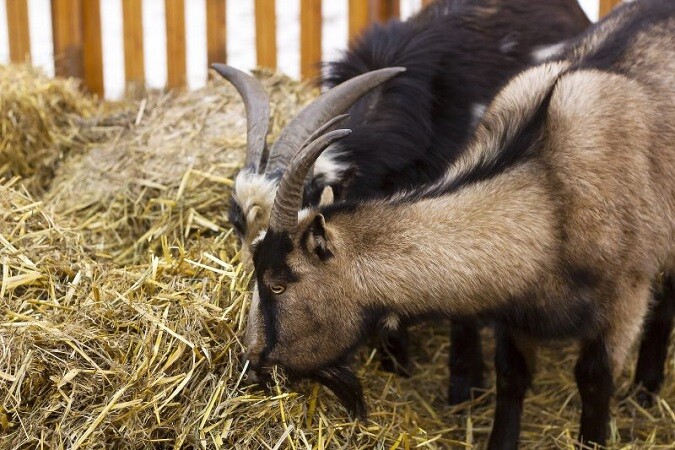

Circling Disease and Silage Sickness are other names for listeriosis in goats, commonly associated with feeding moldy hay. Listeriosis is a life-threatening disease primarily caused by the bacteria Listeria monocytogenes; however, ruminants may also get listeriosis from Listeria ivanovii. Listeria is a zoonotic disease, meaning it can be transmitted from animals to humans.
Listeria can live almost anywhere – in soil, manure piles, grass, and the gastrointestinal tracts of healthy animals. It thrives in aerobic conditions, such as the top layer of silage and moldy hay or feed. It is commonly found in the feces of infected birds, animals, fish, and insects as well as sewage. It can contaminate water, milk, and food. It can withstand temperatures from 34-113 F.
There are two forms of listeriosis in goats: encephalitic and septicemic. Clinical signs of listeriosis are seen more frequently in adult goats than kids.
The encephalitic form has the highest mortality rate and is most prevalent in small ruminants. It is characterized by inflammation of the brain resulting in neurological symptoms. The bacteria enter the body through damaged mucous membranes in the mouth or other openings, and migrates to the brain. Early symptoms are depression, loss of appetite, decreased milk production, and fever. As the brain swells, the animal develops weakness and uncoordination, and will circle in one direction. As the disease progresses, symptoms such as partial facial paralysis, the head pulled back with a rigid neck, ear drooping, salivation, slack jaw, and seizures may appear.
The septicemic form, while also present in ruminants, is most common in single-stomach animals. The bacteria also enter through damaged mucous membranes and then the bloodstream, where it spreads to other organs. It is characterized by diarrhea and abortion. Mastitis caused by L. monocytogenes is rare, but does occur, and results in prolonged shedding of the bacteria in milk. Newborn kids exposed to shedding of listeria in colostrum or milk may show signs of septicemia. It is recommended that aborted kids and placentas be handled with sterile precaution, as people have developed fatal meningitis, septicemia, and rashes on the arms after handling tissues contaminated with listeria.
Treatment
Treatment for listeriosis in goats is high doses of procaine penicillin every six hours until symptoms have disappeared. Sufficient doses are needed to cross the blood/brain barrier and deliver the antibiotic to the central nervous system. While the antibiotic is readily available over the counter, its use in goats is considered extra-labeled, requiring consultation with a veterinarian for proper usage and dosage.
Dexamethasone or Banamine, both requiring prescriptions, are administered to reduce the swelling of the brain. Be aware that Dexamethasone will cause abortion in pregnant Does. Do not use Dexamethazone with Banamine, as it could cause fatal hemorrhaging.
Producers also use herbal remedies in conjunction with pharmaceutical treatment. Usnea extract is made from a lichen that is believed to specifically target listeria bacteria. Thyme, oregano, rosemary, and garlic have also shown therapeutic effectiveness. Apple cider vinegar can help to acidify the rumen. While these may be effective as supportive treatments, they are not able to cross the blood/brain barrier and alone cannot reverse the disease progression.
Intravenous administration of fluids and nutrition may also be necessary for animals that are severely compromised.
Preventing Listeriosis
The best way to prevent listeriosis in goats is good hygiene and sanitation on the farm. Clean soiled feed bunks and water troughs often, to reduce the growth of mold. Keep wild birds away from where the herd feeds. Store feed properly.
Know what to feed goats. Do not feed goats silage unless you are very familiar with handling and storing it. Avoid wet, moldy hay and grain. Moist feeds formulated with molasses have a high incidence of mold, especially in hot weather. Do not feed grass clippings. Do not allow animals to graze boggy areas or close to the ground where the soil has a high pH. Do not feed rough, coarse feed that has a tendency to injure the mouth and predispose an animal to infection.
Protect the rumen balance of your goats. Stressors such as weaning, parasites, sudden weather changes, confinement, changes in herd structure, and abrupt changes in feed can alter the pH of the rumen, making it less acidic and giving the listeria in goats an opportunity to grow. Polio is also triggered by changes in the rumen. Too much grain decreases the pH and leads to decreased thiamine production.
Isolate animals showing symptoms and use sterile precaution when treating. If a doe is shedding listeriosis, raise kids on a milk replacer or milk from a clean doe. In the event of death, submit the animal or aborted tissue to a lab for necropsy. A postmortem is the only way to determine the true cause of death so if other animals in the herd are affected, the proper treatment can be administered. If a postmortem cannot be done, dispose of the carcass by burning.
While you cannot eliminate the presence of listeria in the environment, you can limit the risk of introducing the bacteria and take precautions that will protect your goats from disease.
 Contact Jaguza Support
Contact Jaguza Support